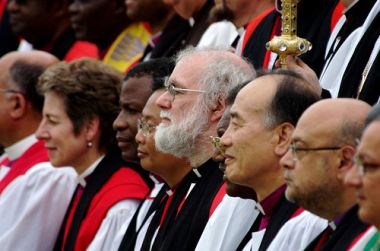Looking back on the last Lambeth Conference

As Anglican bishops from around the world gather for the 2022 Lambeth Conference in Canterbury, Kent, UK, this week, Rev Peter Crumpler recalls his part in the last Conference, back in 2008.
The Lambeth Conference is a major gathering of bishops – usually held around ten years apart, but delayed because of Covid – that brings bishops together to examine issues ranging from climate change to human sexuality. This summer's event includes a series of 'Calls', designed to assess the bishops' views across a range of topics. These are already proving controversial.
Peter helped oversee communications to the media, from broadcasters to blogs, at the Conference. Looking back, he says, "it seems like a different world with the emphasis then on reflection and learning, rather than argument and controversy." He recalls:
Dialogue and sharing experiences from different parts of the Anglican Communion were two of the key themes of the 2008 Lambeth Conference.
During and after the event, I heard numerous bishops telling stories of conversations they had had with their episcopal colleagues from around the world. They were gaining new insights into other bishops' mission and ministry and being enriched by the experience.
This was exactly in line with the wishes of the then Archbishop of Canterbury Rowan Williams and the conference design team. Sir Ellison Pogo, the Archbishop of Melanesia, who chaired the group set this out in the conference programme.
He wrote: "Our task has been to deliver a conference which will have quite a different feel from previous conferences...it should resemble less a parliamentary debating chamber with a string of resolutions but rather provide time for the bishops' spiritual reflection, learning, sharing of experiences and time for discerning more fully the bishops' particular role in God's mission."
Into this context came journalists and commentators from around the world, keen to take the temperature of an Anglican Communion that had been beset by division in the run-up to the conference.
There was much debate over which parts of the Communion would boycott the conference, and whether any bishops within those provinces would defy the ban and attend anyway.
Working with a team of professional communicators from around the world, we sought to provide the journalists with as much information as we could on the conference, while recognising that the design of the event meant that most of the proceedings would be for bishops alone. Only behind closed doors, the organisers felt, would the bishops be able to discuss issues openly and without fixed agendas. Understandably, this led to frustration from many journalists attending.
To help meet this information gap, the communications team organised a media briefing each morning, and a more formal press conference in the afternoon. We sought to brief the media on the topics being discussed each day and arrange for bishops who were expert in the subject to answer their questions. Archbishop Philip Aspinall of Australia ably chaired the afternoon sessions. Outside these events, we kept a press office open on site from early in the morning until late evening.
Back in 2008, although social media was still in its infancy, bloggers were active throughout the conference. As a policy, we had extended media accreditation as broadly as possible, and blog writers were among the journalists at the conference. At this point, it was the newspaper journalists and broadcasters who set the tone for the media coverage.
Looking back from a distance of 14 years – and with some degree of rose-tinted hindsight – some of my personal highlights from the 2008 Lambeth Conference would be:
- Working with a team of professional communicators from the UK and overseas, each committed to serving the Communion and providing reliable information to the journalists attending. Given the conference's structure, this was not always easy but we did our best in challenging circumstances. Others can decide how successful we were.
- Seeing hundreds of bishops and their spouses marching through central London to promote trade justice – and gaining widespread media coverage. A colleague recalled: "It was a glorious day, the hottest of the year, and the sight of hundreds of cassocked bishops and their spouses clothed in national dress ahead of a special Buckingham Palace garden party was truly one to behold." Later, then UK Prime Minister Gordon Brown told the bishops at Lambeth Palace that it was "one of the greatest demonstrations of faith this country has ever seen."
- Listening to Chief Rabbi Jonathan Sacks address the bishops and speak movingly of his education at a Church of England school. To see Rabbi Jonathan and Archbishop Rowan embrace warmly after the talk was a vivid demonstration of mutual friendship and respect. We were able to gain access for the media for this and other evening gatherings.
- Watching Archbishop Rowan in action throughout the conference, seeking to build unity and understanding. His thoughtful, measured contributions helped steer the Conference through to a conclusion regarded by many as successful.
A leader in The Times newspaper towards the end of the conference said of Archbishop Rowan, "by focusing on the Anglican Communion as a Christian community and not as a political organisation, he has ensured that the bulk of the discussion has been on those issues where Christians believe their message to be vital: poverty, global harmony, faith, prayer and charity."
To see the spotlight being shone on those vital gospel issues made the time in Canterbury back in 2008 well spent. I pray that, if feasible, those attending this year's Conference will find their time there just as rewarding and positive.
Rev Peter Crumpler was communications director with the Church of England, from 2004 to 2011. He now serves as an Anglican minister in St Albans, Herts, UK.











